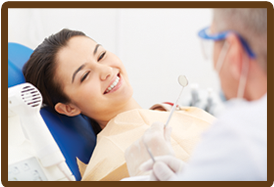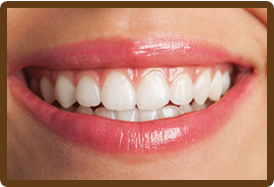CLEANINGS & PREVENTION SERVICES
AT TRU DENTAL, LAS CRUCES, NM
AT TRU DENTAL, LAS CRUCES, NM
A preventive program is a cooperative effort by the patient, Dr. Trujillo and her dental team to preserve the natural dentition and supporting structures by preventing the onset, progress, and recurrence of dental diseases and conditions.
Preventing dental disease starts at home with good oral hygiene and a balanced diet. It is continued in your dental office by the efforts of Dr. Trujillo and her team to promote, restore, and maintain your oral health.
Prevention also includes:
• Regular dental exams
• Cleanings (oral hygiene)
• X-rays
• Sealants and fluoride are also effective preventive treatments that help protect
the teeth.
Prevention helps avoid serious and costly dental problems down the road/in the future and is the KEY to having a healthy, confident, beautiful smile.
Digital radiography (digital x-ray) is the latest technology used to take dental x-rays. This technique uses an electronic sensor (instead of x-ray film) that captures and stores the digital image on a computer. This image can be instantly viewed and enlarged helping the dentist and dental hygienist detect problems easier. Digital x-rays reduce radiation by 80-90% compared to the already low exposure of traditional dental x-rays.
Dental x-rays are essential, preventative, diagnostic tools that provide valuable information not visible to the naked eye. Dr. Trujillo and her Hygiene team use this information to safely and accurately detect hidden dental abnormalities and complete an accurate treatment plan. Without x-rays, problem areas may go undetected and may lead to more costly treatment over time.
Dental x-rays may reveal:
- Abscesses or cysts.
- Bone loss.
- Cancerous and non-cancerous tumors.
- Decay between the teeth.
- Developmental abnormalities.
- Poor tooth and root positions.
- Problems inside a tooth or below the gum line.
Detecting and treating dental problems at an early stage may save you time, money, unnecessary discomfort, and your teeth!
Are dental x-rays safe?
We are all exposed to natural radiation in our environment. Digital x-rays produce a significantly lower level of radiation compared to traditional dental x-rays. Not only are digital x-rays better for the health and safety of the patient, they are also faster and more comfortable to take, which reduces your time in the dental office. Also, since the digital image is captured electronically, there is no need to develop the x-rays, thus eliminating the disposal of harmful waste and chemicals into the environment.
Even though digital x-rays produce a low level of radiation and are considered very safe, dentists still take necessary precautions to limit the patient’s exposure to radiation. These precautions include only taking those x-rays that are necessary, and using lead apron shields to protect the body.
How often should dental x-rays be taken?
The need for dental x-rays depends on each patient’s individual dental health needs. Dr. Trujillo and her team will recommend necessary x-rays based upon the review of your:
- medical and dental history,
- a dental exam,
- signs and symptoms,
- your age,
- risk of disease.
A full mouth series of dental x-rays is recommended for new patients. A full series is usually good for three to five years. Bite-wing x-rays (x-rays of top and bottom teeth biting together) are taken at re-care (maintenance) visits and are recommended once or twice a year to detect new dental problems.
Fluoride is the most effective agent available to help prevent tooth decay. It is a mineral that is naturally present in varying amounts in almost all foods and water supplies. The benefits of fluoride have been well known for over 50 years and are supported by many health and professional organizations.
Fluoride works in two ways:
- Topical fluoride strengthens the teeth once they have erupted by seeping into the outer surface of the tooth enamel, making the teeth more resistant to decay. We gain topical fluoride by using fluoride containing dental products such as toothpaste, mouth rinses, and gels. Dr. Trujillo & her Hygiene team generally recommend children have a professional application of fluoride twice a year during dental re-care visits.
- Systemic fluoride strengthens the teeth that have erupted as well as those that are developing under the gums. We gain systemic fluoride from most foods and our community water supplies. It is also available as a supplement in drop or gel form and can be prescribed by Dr. Trujillo or your physician. Generally, fluoride drops are recommended for infants, and tablets are best suited for children up through the teen years. It is very important to monitor the amounts of fluoride a child ingests. If too much fluoride is consumed while the teeth are developing, a condition called fluorosis (white spots on the teeth) may result.
Although most people receive fluoride from food and water, sometimes it is not enough to help prevent decay. Dr. Trujillo & her Hygiene team may recommend the use of home and/or professional fluoride treatments for the following reasons:
- Deep pits and fissures on the chewing surfaces of teeth.
- Exposed and sensitive root surfaces.
- Fair to poor oral hygiene habits.
- Frequent sugar and carbohydrate intake.
- Inadequate exposure to fluorides.
- Inadequate saliva flow due to medical conditions, medical treatments or medications.
- Recent history of dental decay.
Remember, fluoride alone will not prevent tooth decay! It is important to:
-
brush at least twice a day,
-
floss regularly,
-
eat balanced meals,
-
reduce sugary snacks,
-
visit Dr. Trujillo on a regular basis.
According to research conducted by the American Cancer Society, more than 30,000 cases of oral cancer are diagnosed each year. More than 7,000 of these cases result in the death of the patient. The good news is oral cancer can easily be diagnosed with an annual oral cancer exam, and effectively treated when caught in its earliest stages.
Oral cancer is a pathologic process which begins with an asymptomatic stage during which the usual cancer signs may not be readily noticeable. This makes the oral cancer examinations performed by the dentist critically important. The most common type of oral cancer is the malignant squamous cell carcinoma. This oral cancer type usually originates in lip and mouth tissues.
There are many different places in the oral cavity and maxillofacial region in which oral cancers commonly occur, including:
- Lips
- Mouth
- Tongue
- Salivary Glands
- Oropharyngeal Region (throat)
- Gums
- Face
Reasons for oral cancer examinations
It is important to note that around 75 percent of oral cancers are linked with modifiable behaviors such as smoking, tobacco use and excessive alcohol consumption. Dr. Trujillo can provide literature and education on making lifestyle changes and smoking cessation.
When oral cancer is diagnosed in its earliest stages, treatment is generally very effective. Any noticeable abnormalities in the tongue, gums, mouth or surrounding area should be evaluated by a health professional as quickly as possible. During the oral cancer exam, Dr. Trujillo & her team will be evaluating the maxillofacial and oral regions carefully for signs of pathologic changes.
The following signs will be investigated during a routine oral cancer exam:
- Red patches and sores – Red patches on the floor of the mouth, the front and sides of the tongue, white or pink patches which fail to heal and slow healing sores that bleed easily can be indicative of pathologic (cancerous) changes.
- Leukoplakia – This is a hardened white or gray, slightly raised lesion that can appear anywhere inside the mouth. Leukoplakia can be cancerous, or may become cancerous if treatment is not sought.
- Lumps – Soreness, lumps or the general thickening of tissue anywhere in the throat or mouth can signal pathological problems.
Oral cancer exams, diagnosis and treatment
The oral cancer examination is done once per year during your re-care appointment and is a painless process. During the visual part of the examination, Dr. Trujillo will look for abnormality and feel the face, glands and neck for anything out of the ordinary.
If you have any questions or concerns about oral cancer, don’t hesitate to ask Dr. Trujillo & her team.
Regular dental check ups are essential for maintaining excellent oral hygiene and diagnosing potential problems, but they are not a “fix-all” solution. Thorough oral homecare routines should be practiced on a daily basis to avoid dental problems.
Periodontal disease (also called gum disease and periodontitis) is the leading cause of tooth loss in the developed world, and is completely preventable in the vast majority of cases. Professional cleanings twice a year combined with daily thorough homecare can remove a high percentage of disease-causing bacteria and plaque.
There are numerous types of oral hygiene aids on the supermarket shelves, and it can be difficult to determine which will provide the best benefit to your oral health.
Here are some of the most common oral hygiene aids for homecare:
- Dental Flosses
Dental floss is the most common interdental and subgingival (below the gum) cleaner and comes in a variety of types and flavors. The floss itself can help remove food particles and plaque from between the teeth. Vigorous flossing with a floss holder can cause soft tissue damage and bleeding, so great care should be taken. Floss should normally be used twice daily. We recommend woven floss to assist with plque removal. The technique used when flossing plays a big role in in its effectiveness. We are happy to show you this technique!
- Interdental Cleaners
Many hygienist & periodontists recommend interdental brushes in addition to dental floss. These tiny brushes are gentle on the gums and very effective in cleaning the contours of teeth in between the gums. Interdental brushes come in various shapes and sizes.
- Mouth Rinses
There are two basic types of mouth rinse available: Cosmetic rinses which are sold over the counter and temporarily suppress bad breath, and therapeutic rinses which may or may not require a prescription. Therapeutic rinses, are regulated by the FDA and contain active ingredients that can help reduce bad breath, plaque, and cavities, whereas cosmetic rinses do not. Mouth rinses should generally be used after brushing.
- Oral Irrigators
Oral irrigators, like Water Jets and Waterpiks have been created to clean debris from below the gum line. Water is continuously sprayed from tiny jets into the gum pockets which can help remove harmful bacteria and food particles. Overall, oral irrigators have proven effective in lowering the risk of gum disease and should not be used instead of brushing and flossing. Professional cleanings are recommended at least twice annually to remove deeper debris.
- Rubber Tip Stimulators
The rubber tip stimulator is an excellent tool for removing plaque from around the gum line and also for stimulating blood flow to the gums. The rubber tip stimulator should be traced gently along the outer and inner gum line at least once each day. Any plaque on the tip can be rinsed off with tap water. It is important to replace the tip as soon as it starts to appear worn, and to store the stimulator in a cool, dry place.
- Tongue Cleaners
Tongue cleaners are special devices designed to remove the buildup of bacteria, fungi and food debris from the tongue surface. [The fungi and bacteria that colonize on the tongue have been related to halitosis (bad breath) and a great many systemic diseases like diabetes, heart disease, respiratory disease and stroke.] Tongue cleaners can be made from metal, wood or plastic and shaped in accordance with the contours of the tongue.
- Toothbrushes
There are many toothbrush types available. Electric toothbrushes are generally recommended by dentists because studies have shown electric brushes are much more effective than manual brushes. The vibrating or rotary motion helps to dislodge plaque and remove food particles from around the gums and teeth. The same results can be obtained using a manual brush, but more effort is needed to do so.
Manual toothbrushes & electric toothbrush heads should be replaced every three (3) months because worn bristles become ineffective over time. Soft bristle toothbrushes are far less damaging to gum tissue than medium and hard bristle varieties. In addition, an appropriate sized ADA approved toothbrush should be chosen to allow proper cleaning to all the teeth. Teeth should ideally be brushed after each meal, or minimally twice each day.
If you have any questions about oral hygiene aids, please ask Dr. Trujillo & her team.
Panoramic X-rays (also known as Panorex® or orthopantomograms) are wraparound x-rays of the face and teeth. They offer a view that would otherwise be invisible to the naked eye. X-rays in general, expose hidden structures, such as wisdom teeth, reveal preliminary signs of cavities, and also show fractures and bone loss.
Panoramic X-rays are extraoral and simple to perform. A panoramic x-ray is not conducted to give a detailed view of each tooth, but rather to provide a better view of the sinus areas, nasal areas and mandibular nerve.
Panoramic X-rays are extremely versatile in dentistry, and are used to:
- Assess patients with an extreme gag reflex.
- Evaluate the progression of TMJ.
- Expose cysts and abnormalities.
- Expose impacted teeth.
- Expose jawbone fractures.
- Plan treatment (full and partial dentures, braces and implants).
A sealant is a thin, plastic coating applied to the chewing surface of molars, premolars and any deep grooves (called pits and fissures) of teeth. More than 75% of dental decay begins in these deep grooves. Teeth with these conditions are hard to clean and are very susceptible to decay. A sealant protects the tooth by sealing deep grooves, creating a smooth, easy to clean surface.
Sealants can protect teeth from decay for many years, but need to be checked for wear and chipping at regular dental visits.
Reasons for sealants:
- Children and teenagers – As soon as the six-year molars (the first permanent back teeth) appear or any time throughout the cavity prone years of 6-16.
- Adults – Tooth surfaces without decay that have deep grooves or depressions.
- Baby teeth – Occasionally done if teeth have deep grooves or depressions and child is cavity prone.
What do sealants involve?
Sealants are easily applied by Dr. Trujillo and her Hygiene team and the process takes only a couple of minutes per tooth.
The teeth to be sealed are thoroughly cleaned and then surrounded with cotton to keep the area dry. A special solution is applied to the enamel surface to help the sealant bond to the teeth. The teeth are then rinsed and dried. Sealant material is carefully painted onto the enamel surface to cover the deep grooves or depressions. Depending on the type of sealant used, the material will either harden automatically or with a special curing light.
Proper home care, a balanced diet, and regular dental visits will aid in the life of your new sealants.
Dental Exam
A comprehensive dental exam will be performed by Dr Trujillo at your initial dental visit. At regular check-up exams, Dr. Trujillo & her team will include the following:
- Examination of diagnostic x-rays (radiographs): Essential for detection of decay, tumors, cysts, and bone loss. X-rays also help determine tooth and root positions.
- Oral cancer screening: Check the face, neck, lips, tongue, throat, tissues, and gums for any signs of oral cancer.
- Gum disease evaluation: Check the gums and bone around the teeth for any signs of periodontal disease.
- Examination of tooth decay: All tooth surfaces will be checked for decay with special dental instruments.
- Examination of existing restorations: Check current fillings, crowns, etc.
Professional Dental Cleaning
Professional dental cleanings (dental prophylaxis) are usually performed by Registered Dental Hygienists. Your cleaning appointment will include a dental exam and the following:
- Removal of calculus (tartar): Calculus is hardened plaque that has been left on the tooth for some time and is now firmly attached to the tooth surface. Calculus forms above and below the gum line and can only be removed with special dental instruments.
- Removal of plaque: Plaque is a sticky, almost invisible film that forms on the teeth. It is a growing colony of living bacteria, food debris, and saliva. The bacteria produce toxins (poisons) that inflame the gums. This inflammation is the start of periodontal disease!
- Teeth polishing: Remove stain and plaque that is not otherwise removed during tooth brushing and scaling.
Dental radiographs (x-rays) are essential, preventative, diagnostic tools that provide valuable information not visible during a regular dental exam. Dr. Trujillo & her Hygiene team use this information to safely and accurately detect hidden dental abnormalities and complete an accurate treatment plan. Without x-rays, problem areas may go undetected.
Dental x-rays may reveal:
- Abscesses or cysts.
- Bone loss.
- Cancerous and non-cancerous tumors.
- Decay between the teeth.
- Developmental abnormalities.
- Poor tooth and root positions.
- Problems inside a tooth or below the gum line.
Detecting and treating dental problems at an early stage can save you time, money, unnecessary discomfort, and your teeth!
Are dental x-rays safe?
We are all exposed to natural radiation in our environment. The amount of radiation exposure from a full mouth series of x-rays is equal to the amount a person receives in a single day from natural sources.
Dental x-rays produce a low level of radiation and are considered safe. Dr. Trujillo and her team take necessary precautions to limit the patient’s exposure to radiation when taking dental x-rays. In our office, precautions include using lead apron shields to protect the body and using modern, digital sensors that cut down the exposure time of each x-ray.
How often should dental x-rays be taken?
The need for dental x-rays depends on each patient’s individual dental health needs. Dr. Trujillo & her Hygiene team will recommend necessary x-rays based on the review of your medical and dental history, dental exam, signs and symptoms, age consideration, and risk for disease.
A full mouth series of dental x-rays is recommended for new patients. A full series is usually good for three to five years. Bite-wing x-rays (x-rays of top and bottom teeth biting together) are taken at recall (check-up) visits and are recommended once or twice a year to detect new dental problems.
A beautiful, healthy smile that lasts a lifetime is our ultimate goal when treating patients. Your personal home care plays an important role in achieving that goal. Your personal home care starts by:
- eating balanced meals
- reducing the number of snacks you eat
- correctly using the various dental aids that help control the plaque and bacteria that cause dental disease
Tooth brushing – Brush your teeth at least twice a day (especially before going to bed at night) with an ADA approved soft bristle brush and toothpaste.
Flossing – Daily flossing is the best way to clean between the teeth and under the gumline. Flossing not only helps clean these spaces, it disrupts plaque colonies from building up, preventing damage to the gums, teeth, and bone.
Rinsing – It is important to rinse your mouth with water after brushing, and also after meals if you are unable to brush.
Other dental aids we highly recommend:
- Interdental brushes
- rubber tip stimulators
- tongue cleaners
- irrigation devices
- fluoride
- medicated rinses
All play a role in good dental home care.
Brushing and flossing are of paramount importance to oral hygiene. Though bi-annual professional dental cleanings remove plaque, tartar and debris, excellent homecare methods are equally valuable. Proper brushing and flossing can enhance the health of the mouth, make the smile sparkle and prevent serious diseases.
Reasons why proper brushing and flossing are essential:
- Prevention of tooth decay – Tooth decay is one of the leading causes of tooth loss, and its treatment often requires complex dental procedures. Tooth decay occurs when the acids found in plaque erode the natural enamel found on the teeth. This phenomenon can easily be prevented by using proper home hygiene methods.
- Prevention of periodontal disease – Periodontal disease is a serious, progressive condition which can cause tooth loss, gum recession and jawbone recession. Periodontal disease is caused by the toxins found in plaque, and can lead to serious health problems in other parts of the body. Removing plaque and calculus (tartar) from the surface of the tooth using a toothbrush, and from the interdental areas using dental floss, is an excellent way to stave off periodontal problems.
- Prevention of halitosis – Bad breath or halitosis is usually caused by old food particles on or between the teeth. These food particles can be removed with regular brushing and flossing; leaving the mouth healthier, and breath smelling fresher.
- Prevention of staining – Staining or the yellowing of teeth can be caused by a wide variety of factors such as smoking, coffee and tea. The more regularly these staining agents are removed from the teeth using brushing and flossing techniques, the less likely it is that the stains will become permanent.
The Proper Way to Brush
The teeth should be brushed at least twice a day; ideally in the morning and before bed. The perfect toothbrush is small in size with soft, rounded-end bristles and no more than three months old. The head of the brush needs to be small enough to access all areas of the mouth, and the bristles should be soft enough so as not to cause undue damage to the gum tissue. The American Dental Association (ADA) has given electric toothbrushes their seal of approval; stating that those with rotating or oscillating heads are more effective than other toothbrushes.
Here is a basic guide to proper brushing:
- Place the toothbrush at a 45-degree angle where the gums and teeth meet.
- Use small circular motions to gently brush the gumline and teeth.
- Do not scrub or apply too much pressure to the teeth, as this can damage the gums and tooth enamel.
- Brush every surface of every tooth, cheek-side, tongue-side, and chewing surfaces. Place special emphasis on the surfaces of the back teeth.
- Use back and forth strokes to brush the chewing surfaces.
- Brush the tongue to remove fungi, food and debris.
The Proper Way to Floss
Flossing is a great way to remove plaque from the interdental regions (between the teeth). Flossing is an especially important tool for preventing periodontal disease and limiting the depth of the gum pockets. The interdental regions are difficult to reach with a toothbrush and should be cleansed with dental floss on a daily basis. The flavor and type of floss are unimportant; choose floss that will be easy and pleasant to use.
Here is a basic guide to proper flossing:
- Cut a piece of floss to around 18 inches long.
- Wrap one end of the floss around the middle finger of the left hand and the other end around the middle finger of the right hand until the hands are 2-3 inches apart.
- Work the floss gently between the teeth toward the gum line.
- Curve the floss in a U-shape around each individual tooth and carefully slide it beneath the gum line.
- Carefully move the floss up and down several times to remove interdental plaque and debris.
- Do not pop the floss in and out between the teeth as this will inflame and cut the gums.
If you have any questions about the correct way to brush or floss, please ask Dr. Trujillo & her team.















